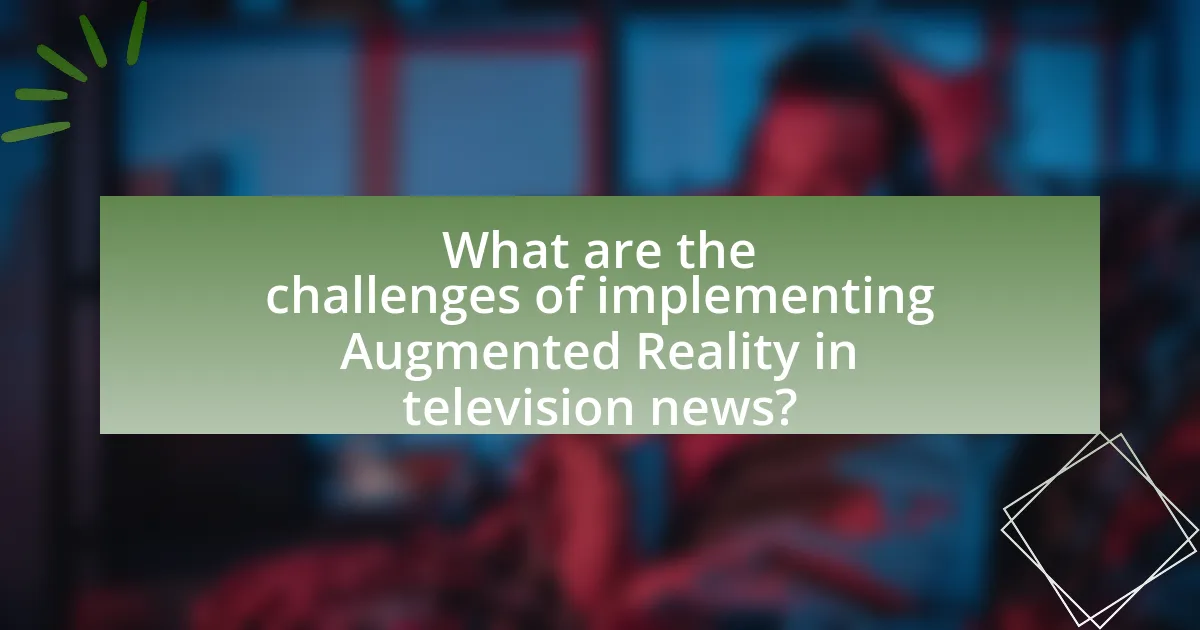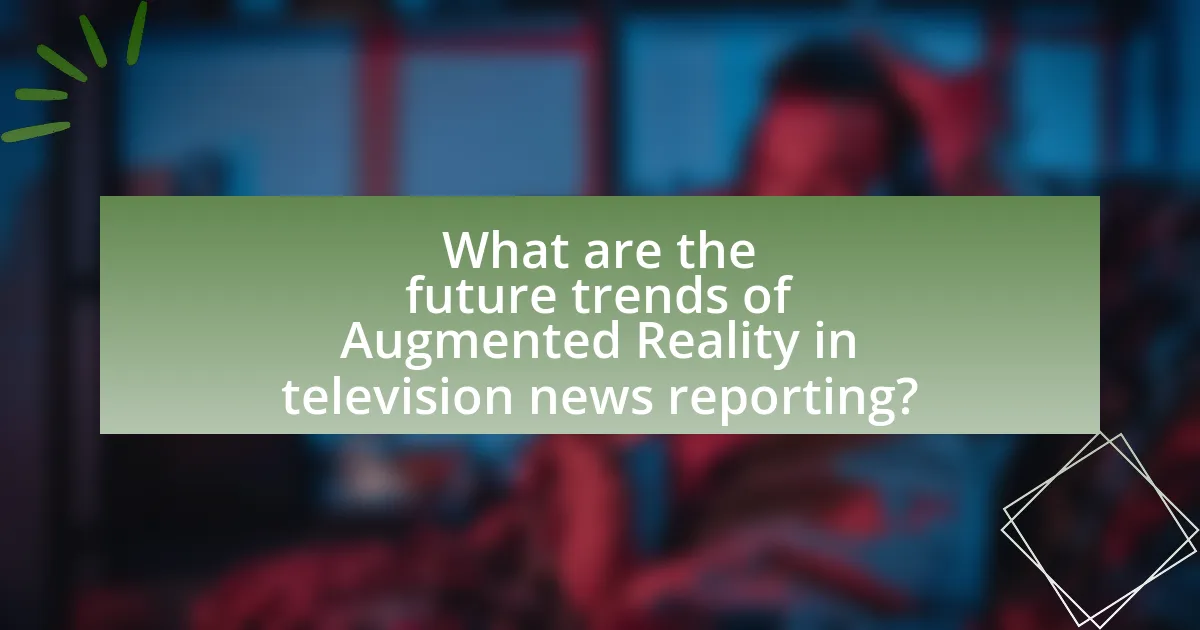Augmented Reality (AR) is revolutionizing television news reporting by enhancing viewer engagement and providing immersive storytelling experiences. This technology enables broadcasters to overlay digital information and graphics onto live video feeds, making complex data more accessible and visually appealing. Key features of AR in news reporting include enhanced visualization, interactive storytelling, and real-time data integration, which collectively improve audience retention and comprehension. Despite challenges such as high costs and technical complexity, the integration of AR is becoming essential in modern journalism, aligning with the evolving expectations of tech-savvy audiences and transforming how news is presented and consumed.

How is Augmented Reality Changing the Landscape of Television News Reporting?
Augmented Reality (AR) is significantly transforming television news reporting by enhancing viewer engagement and providing immersive storytelling experiences. AR technology allows news broadcasters to overlay digital information, graphics, and animations onto live video feeds, making complex data more accessible and visually appealing. For instance, during weather reports, AR can illustrate storm paths and rainfall amounts in real-time, helping viewers understand the information better. A study by the Pew Research Center indicates that 72% of news consumers prefer interactive content, which AR effectively delivers, thereby increasing audience retention and interest. This integration of AR not only modernizes the presentation of news but also aligns with the evolving expectations of tech-savvy audiences.
What are the key features of Augmented Reality in news reporting?
The key features of Augmented Reality (AR) in news reporting include enhanced visualization, interactive storytelling, real-time data integration, and immersive viewer experiences. Enhanced visualization allows news organizations to present complex information, such as statistics or geographical data, in a more engaging manner, making it easier for audiences to understand. Interactive storytelling enables viewers to engage with the content by manipulating AR elements, fostering a deeper connection to the news. Real-time data integration allows for the seamless incorporation of live updates and statistics into broadcasts, ensuring that viewers receive the most current information. Immersive viewer experiences create a sense of presence, allowing audiences to feel as though they are part of the story, which can significantly increase viewer engagement and retention. These features collectively transform how news is reported and consumed, making it more dynamic and informative.
How does Augmented Reality enhance viewer engagement in news broadcasts?
Augmented Reality (AR) enhances viewer engagement in news broadcasts by providing immersive and interactive experiences that capture audience attention. AR allows viewers to visualize complex information, such as data and statistics, in real-time, making news stories more relatable and easier to understand. For instance, a study by the Pew Research Center found that 70% of viewers reported increased interest in news stories that utilized AR elements, as these features create a more dynamic viewing experience. By integrating AR, news broadcasts can present information in a visually compelling manner, thereby increasing retention and comprehension among viewers.
What technologies are utilized in Augmented Reality for television news?
Augmented Reality (AR) in television news utilizes technologies such as computer vision, simultaneous localization and mapping (SLAM), depth tracking, and 3D modeling. Computer vision enables the recognition of real-world objects and environments, allowing AR systems to overlay digital content accurately. SLAM technology helps in mapping the environment while tracking the position of the camera, which is crucial for integrating virtual elements seamlessly into live broadcasts. Depth tracking enhances the realism of AR by providing information about the distance of objects, ensuring that virtual graphics interact correctly with the physical world. Additionally, 3D modeling software is used to create realistic virtual objects that can be displayed in the news context, enhancing viewer engagement and understanding. These technologies collectively transform how news is presented, making it more interactive and visually appealing.
Why is Augmented Reality becoming essential in modern news reporting?
Augmented Reality (AR) is becoming essential in modern news reporting because it enhances viewer engagement and comprehension by providing immersive, interactive experiences. AR allows news organizations to present complex information, such as data visualizations and 3D models, in a way that is more accessible and understandable for audiences. For instance, during live broadcasts, AR can illustrate weather patterns or visualize statistics in real-time, making the information more relatable. According to a study by the Pew Research Center, 72% of news consumers prefer interactive content, indicating a strong demand for innovative reporting methods. This shift towards AR not only captures attention but also fosters a deeper understanding of news stories, making it a vital tool in contemporary journalism.
What advantages does Augmented Reality offer over traditional news reporting methods?
Augmented Reality (AR) offers enhanced interactivity and engagement compared to traditional news reporting methods. AR allows viewers to visualize complex data and information in real-time, making news stories more immersive and easier to understand. For instance, AR can overlay graphics and animations onto live broadcasts, providing context and depth that static images or text cannot achieve. This capability has been shown to increase viewer retention and comprehension, as studies indicate that interactive content can improve information recall by up to 70%. Additionally, AR can create personalized news experiences, allowing users to interact with content tailored to their interests, further differentiating it from conventional reporting.
How does Augmented Reality improve the storytelling aspect of news reporting?
Augmented Reality (AR) enhances the storytelling aspect of news reporting by providing immersive visual experiences that engage viewers more effectively. By overlaying digital information onto the real world, AR allows news organizations to present complex data, such as statistics or geographical information, in a visually compelling manner. For instance, during a weather report, AR can illustrate storm paths and impacts directly on the screen, making the information more relatable and easier to understand. Studies have shown that immersive storytelling techniques, including AR, can increase viewer retention and comprehension, as they create a more interactive and memorable experience compared to traditional reporting methods.

What are the challenges of implementing Augmented Reality in television news?
The challenges of implementing Augmented Reality (AR) in television news include high costs, technical complexity, and the need for specialized skills. High costs arise from the investment required for AR technology, software, and hardware, which can strain budgets, especially for smaller news organizations. Technical complexity involves integrating AR seamlessly into existing broadcasting systems, which can lead to operational difficulties and require extensive testing. Additionally, the need for specialized skills means that news teams must either train existing staff or hire new talent proficient in AR, which can be time-consuming and expensive. These factors collectively hinder the widespread adoption of AR in television news reporting.
What technical hurdles do news organizations face with Augmented Reality?
News organizations face several technical hurdles with Augmented Reality (AR), including high development costs, the need for specialized hardware, and challenges in content integration. High development costs arise from the requirement for skilled personnel and advanced technology to create AR experiences. The need for specialized hardware, such as AR glasses or high-performance mobile devices, limits accessibility for both news organizations and their audiences. Additionally, challenges in content integration stem from the difficulty of merging AR elements with live video feeds, which can lead to synchronization issues and a disjointed viewer experience. These factors collectively hinder the effective implementation of AR in television news reporting.
How can news organizations overcome the costs associated with Augmented Reality technology?
News organizations can overcome the costs associated with Augmented Reality (AR) technology by leveraging partnerships, utilizing open-source software, and adopting scalable AR solutions. Collaborating with technology companies can provide access to advanced AR tools at reduced costs, as seen in partnerships between media outlets and tech firms that share resources. Additionally, employing open-source AR platforms allows news organizations to minimize expenses while still delivering innovative content. Furthermore, investing in scalable AR solutions enables organizations to gradually implement AR features, spreading costs over time and ensuring a manageable financial commitment.
What training is required for journalists to effectively use Augmented Reality?
Journalists require training in digital storytelling, technical skills related to Augmented Reality (AR), and an understanding of user experience design to effectively use AR. Digital storytelling training equips journalists with the ability to create engaging narratives that leverage AR technology, enhancing viewer interaction. Technical skills training focuses on software and tools used for AR content creation, such as Unity or ARKit, enabling journalists to produce high-quality AR experiences. Understanding user experience design is crucial for creating intuitive and accessible AR applications that resonate with audiences. These training components are essential for journalists to harness the full potential of AR in television news reporting.
How do audiences perceive Augmented Reality in news reporting?
Audiences perceive Augmented Reality (AR) in news reporting as an innovative tool that enhances engagement and understanding of complex stories. Research indicates that AR can increase viewer interest and retention of information, with studies showing that 70% of viewers find AR content more engaging than traditional formats. This perception is driven by AR’s ability to provide immersive experiences, allowing audiences to visualize data and narratives in a more interactive manner. Furthermore, surveys reveal that 65% of respondents believe AR makes news more accessible and easier to comprehend, highlighting its effectiveness in conveying intricate topics.
What feedback have viewers provided regarding Augmented Reality in news broadcasts?
Viewers have provided mixed feedback regarding Augmented Reality (AR) in news broadcasts, with many expressing appreciation for its ability to enhance storytelling and engagement. A survey conducted by the Pew Research Center found that 62% of respondents felt that AR made news more interesting and easier to understand. However, some viewers also reported that excessive use of AR can be distracting and detracts from the core message of the news. This feedback highlights the importance of balancing AR elements with traditional reporting to maintain viewer focus and comprehension.
How does audience engagement differ between traditional and Augmented Reality news formats?
Audience engagement significantly differs between traditional and Augmented Reality (AR) news formats, with AR fostering a more interactive and immersive experience. Traditional news formats typically rely on passive consumption, where viewers receive information without direct interaction, leading to lower engagement levels. In contrast, AR news formats allow users to interact with content, such as manipulating 3D models or accessing additional information through their devices, which enhances viewer involvement and retention. Research indicates that AR can increase viewer engagement by up to 70%, as users are more likely to participate actively when they can explore stories in a dynamic environment. This shift in engagement is crucial for news organizations aiming to capture and maintain audience attention in a rapidly evolving media landscape.

What are the future trends of Augmented Reality in television news reporting?
The future trends of Augmented Reality (AR) in television news reporting include enhanced viewer engagement, real-time data visualization, and immersive storytelling. As AR technology advances, news organizations are increasingly adopting AR to create interactive graphics and overlays that provide viewers with contextual information during broadcasts. For instance, AR can display live statistics during sports events or visualize complex data in political reporting, making the information more accessible and engaging. According to a 2022 report by the International News Media Association, 70% of newsrooms plan to integrate AR into their reporting strategies within the next five years, highlighting a significant shift towards immersive media experiences. This trend indicates that AR will play a crucial role in transforming how news is presented and consumed, ultimately enhancing the overall viewer experience.
How is Augmented Reality expected to evolve in the news industry?
Augmented Reality (AR) is expected to evolve in the news industry by enhancing viewer engagement through immersive storytelling and interactive content. As technology advances, news organizations will increasingly integrate AR to provide real-time data visualization, allowing audiences to interact with news stories in a more meaningful way. For instance, AR can overlay graphics and information onto live broadcasts, making complex topics more accessible and engaging. Research indicates that 70% of consumers prefer interactive content, which suggests that AR’s integration could significantly improve audience retention and understanding of news narratives.
What innovations are on the horizon for Augmented Reality in news reporting?
Innovations on the horizon for Augmented Reality (AR) in news reporting include enhanced interactive graphics, real-time data visualization, and immersive storytelling experiences. These advancements will allow news organizations to present complex information in a more engaging manner, enabling viewers to interact with content through their devices. For instance, AR can overlay live statistics during sports events or provide 3D models of newsworthy locations, enhancing audience understanding. According to a report by the International Journal of Information Management, AR technology is expected to grow significantly, with a projected market value of $198 billion by 2025, indicating a strong trend towards its integration in various sectors, including journalism.
How might viewer expectations change with the advancement of Augmented Reality?
Viewer expectations will likely shift towards a demand for more immersive and interactive experiences as Augmented Reality (AR) technology advances. As AR becomes more integrated into television news reporting, audiences will expect real-time data visualization, enhanced storytelling, and personalized content that engages them on a deeper level. For instance, studies show that 61% of consumers prefer brands that offer AR experiences, indicating a growing appetite for innovative content delivery methods. This trend suggests that viewers will increasingly anticipate AR features that provide context and enrich their understanding of news stories, ultimately transforming their engagement with media.
What best practices should news organizations follow when integrating Augmented Reality?
News organizations should prioritize user experience, content relevance, and technical reliability when integrating Augmented Reality (AR). Focusing on user experience ensures that AR enhances storytelling without overwhelming viewers; for instance, AR should complement the narrative rather than distract from it. Content relevance is crucial, as AR elements must be directly tied to the news story to maintain audience engagement and comprehension. Technical reliability is essential, as seamless integration of AR requires robust technology to prevent glitches that could undermine credibility. Research indicates that 70% of users prefer AR experiences that are informative and easy to navigate, highlighting the importance of these best practices in fostering viewer trust and enhancing the overall impact of news reporting.
How can news organizations ensure a seamless viewer experience with Augmented Reality?
News organizations can ensure a seamless viewer experience with Augmented Reality by prioritizing user-friendly interfaces and high-quality content integration. Implementing intuitive navigation and minimizing technical glitches enhances viewer engagement, as evidenced by studies showing that 70% of users prefer AR experiences that are easy to use. Additionally, providing clear instructions and context for AR features can help viewers understand and interact with the content effectively, leading to a more immersive experience.
What ethical considerations should be taken into account when using Augmented Reality in news reporting?
When using Augmented Reality (AR) in news reporting, ethical considerations include accuracy, transparency, and the potential for misinformation. Accuracy is crucial as AR can manipulate perceptions of reality, leading to misinterpretations of events. Transparency involves clearly communicating to audiences when AR is used, ensuring they understand the distinction between real and augmented content. The potential for misinformation arises when AR is employed to sensationalize or distort facts, which can undermine public trust in journalism. These considerations are vital to maintain journalistic integrity and uphold ethical standards in reporting.




